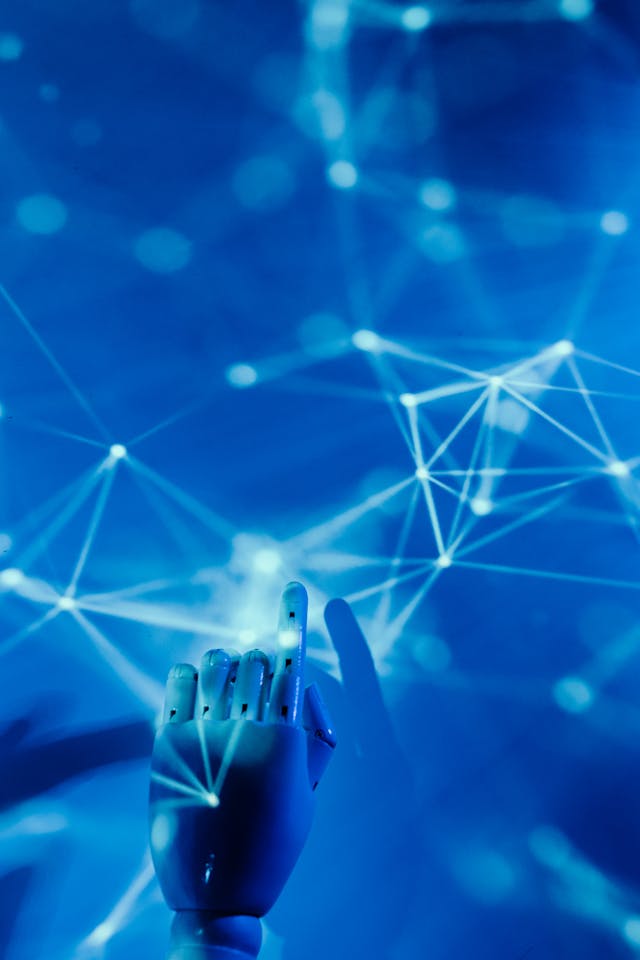In this technological era that is fast evolving more than we can escape, Artificial intelligence (AI) is the leading technology. From voice assistants in our houses to algorithms running the world economies, AI is no longer a sci-fi dream but an actual force changing the way we live in the world. But absolute power has to come with absolute responsibility. While we anticipate incredible opportunities from this surge in AI, at the same time we have potentially serious risks to societies, economies and even ethical frameworks.
This blog post explores the double-edged sword of AI in detail. We’ll dive into the fascinating possibilities it will enable, the risks that will follow and some practical steps that individuals and businesses can take if they want to implement it to its fullest potential – along with ways to avoid the downsides. Whether you’re a tech enthusiast, a business leader, or simply curious about the future, understanding the trajectory of AI is important. Stick around to the end for some tips that you can action to change the way you interact with this technology.
Explosive Growth of AI: Brief Introduction
Understanding the emergence of AI starts by explaining its fundamentals. AI stands for Artificial Intelligence, and it is defined as a system or machine that uses human intelligence to carry out tasks, learn from data and make decisions. What started with rule-based programs in the 1950s has grown exponentially with the development of systems for machine learning, neural networks and big data.
Key milestones include:
- 2010s Boom: Deep learning breakthroughs, such as AlphaGo’s emergence as the winner of human Go champions in 2016, demonstrated the power of AI.
- 2020s Acceleration: Generative AI applications such as ChatGPT (introduced in 2022) democratized access and AI is now a household name.


Opportunities Brought On by AI: The Paradigm Shift in Industries and Lives
AI’s opportunities are numerous, for example in health care, education, business, and many others. By automating routine task data processing, forming better decision-making processes, and creating new abilities, AI has made it possible for us to solve complicated problems more efficiently. Here I will go over some of the most promising areas.
- Revolutionizing Healthcare
AI is a game changer for medicine, in which speed and accuracy can save lives. Diagnostics based on AI like IBM Watson Health, use AI based tools to analyse the medical images and detect the cancer earlier than a human radiologist – often with 95% accuracy. During the time of the pandemic caused by the COVID-19 virus, AI models were used to predict the outbreak pattern and accelerate the vaccine development phase.
The future of personalised medicine is here. AI algorithms can be used to customize treatment for a patient based on his or her genetic profile or lifestyle and real-time health data obtained from wearables. Imagine an AI companion monitoring your vitals and identifying to doctors any anomalies before your symptoms appear. The World Health Organization estimates a 5-10% cost reduction for healthcare cost due to utilization of AI and improved outcomes in underserved areas.
For businesses in health tech, this means new revenue streams: From AI-powered telemedicine platforms to predictive analytics for pharmaceutical drug discovery. According to Deloitte, we have heard that, using AI could help increase efficiency by over 40% in the industry. - Improving Business and Financial Productivity
In view of this, AI is the ultimate efficiency hack for the corporate world. Robotic process automation (RPA) and other automation devices are employed to remove routine tasks – such as data entry or processing invoices – so that employees have time for creative activity. AI is employed for inventory management, preventing waste production and streamlining supply chains for companies such as Amazon.
In finance, animated machines efficiently detect fraud by scanning millions of transactions in seconds, enabling billions in annual losses to be prevented annually. Artificial intelligence-powered algorithmic trading is smarter and faster than human traders and contributes to market stability. A PwC report predicts AI will contribute $15.7 trillion to the global economy by 2030, with finance leading the charge.
For small firms, available AI technology such as chatbots (e.g. Google Dialogflow) can make customer service available on a 24/7 basis, and increase satisfaction rating by 20-30%. - Increasing Education and Brainpower
AI breaks down democracy of learning – it has never happened. For example, Duolingo has a personalized approach: its study algorithm which promotes more than 30% retention in the learning process. In the education system, AI tutors are present that give immediate feedback and make it possible for quality teaching to reach millions of people in remote areas.
Creativity gets a boost too. DALL-E generates art from verbal cues and Midjourney helps designers. Writers and musicians use AI for brainstorming and boosting innovation. From better skills training, UNLV notes that AI could improve income inequality by lifting 250 million people out of poverty, according to the U.N. Educational, Scientific and Cultural Organisation (UNESCO). - Environmental and Social Good
Climate change: AI takes it to the frontline. Google DeepMind and how it revolutionised wind farm power output: AI got Google DeepMind to approximate higher than 20% in wind farm energy output. AI is already being used in conservation by tracking deforestation from satellite images and sending alerts to officials if illegal logging is being observed.
AI is more socially accessible – speech to text for the hearing impaired or facial recognition for inclusive secure systems. It is these applications which demonstrate AI’s potential for a more equal world.
In summary, the opportunities of AI are limitless, and it is responsible for economic growth, innovation, and society’s progress.
The Shadow Side: Risks and Challenges of the Rise of AI
Though the advantages of artificial intelligence are impressive, it is irresponsible to overlook the risks. Unchecked AI could drive disparities in people and decrease trust as it might displace jobs and create ethical quandaries for humans. Let’s examine the key threats.
- Job Take and Economic Inequality
AI automation puts millions of jobs at risk. The Oxford Martin School pegs that at 47% of US jobs in serious danger, especially those in manufacturing, retail and transport. Self-driving trucks could do away with jobs for 3.5 million American drivers, according to The American Trucking Associations.
This isn’t just a blue-collar and white-collar job – even fields of significance considered white-collar, such as legal research and accounting, have their ones AI rivals. The result? Widening inequality. While AI creates jobs in tech (e.g. data scientists), the transition leaves a lot behind – especially in developing nations. Policymakers are required to reskill at an investment level, otherwise it may lead to social unrest. - Privacy and Surveillance Issues
AI thrives on data but how does it come at what cost? Government- and company-used facial recognition tech raises Orwellian fears. In China, AI surveillance watches over the citizens; in the West, apps such as Clearview AI, scrape billions of faces without consent.
Data breaches magnify risks – Cambridge Analytica’s scandal frightened us how AI is being used to manipulate elections. Laws like GDPR do help, but there is still a long way to go in terms of enforcing them. For users, this mean constant monitoring and, for businesses, this could translate to substantial fines (up to 4% of global revenue), if they do not comply. - Bias and Ethical Dilemmas
AI isn’t progressive – if you see a problem with human bias in AI, you’re not wrong. Amazon’s hiring AI discriminate women because It was trained On male-dominated resumes. In the criminal justice system, the biased algorithms, such as COMPAS, misjudges recidivism for black defendants and maintains injustice.
Ethical issues lie within the development of autonomous weapons (“killer robots”) and of deepfakes, which are means of spreading misinformation. In 2023, MIT conducted a study where they determined that deepfakes could influence 20% of election voters. Who decides AI’s morals? Initiatives such as the EU’s AI Act will ensure that high-risk AI is classified and require transparency, but for example, global standards are needed. - Security Threats and Existential Risks
Cybersecurity is one area of AI that has become a battlefield for it. Hackers apply AI for high-level phishing or ransomware, defenders fire back with AI guards. But vulnerabilities remain – adversarial attacks can trick self-driving cars into crashing.
On a much larger scale, superintelligent AI is an existential threat. Thinkers like Elon Musk warn that AI is leading to an “artificial arms race” that could have unforeseen results. While sci-fi exists, experts such as Nick Bostrom are of the opinion that we need to get AI on board with human.
Shaping the Future: Balancing Opportunities and Threats
So how is it possible to enjoy the dawn of AI without leading to disaster? The solution is proactive strategies.
For Individuals:
- Upskill: Learn AI basics via free platforms like Coursera. Focus on complementary skills like critical thinking.
- Protect Privacy: Use tools like VPNs and demand transparent AI from companies.
- Stay Informed: Follow sources like our blog for balanced insights.
For Businesses:
- Ethical AI Frameworks: Adopt guidelines from IEEE or Google’s Responsible AI Practices.
- Diversify: Use AI to augment, not replace, human roles—hybrid models yield the best results.
- Invest in Security: Partner with AI ethics experts to audit systems.
For Policymakers:
- Global cooperation on regulations, like the UN’s AI advisory body.
- Universal basic income pilots to cushion job losses.
In order to direct AI towards a positive future, it is critical to proactively tackle risks. While some might worry about AI as the final nail in the coffin of humanity’s power, the emergence of this technology is a canvas for human ingenuity.
Conclusion: Harnessing the AI Era with Caution
The rise of AI opportunities and risks It’s a story of high stakes transformation. From curing diseases to automating drudgery, AI has many benefits; from prejudicing to job loss, it requires caution. As we stand right now at this crossroads, what decisions we make now will be the decisions of tomorrow.
If you are ready to get into using AI for your business or personal growth, then check out this information. What’s your take on AI’s future? Let’s talk about it, please share in the comments.
Discover more from Tech Trend Insights
Subscribe to get the latest posts sent to your email.
